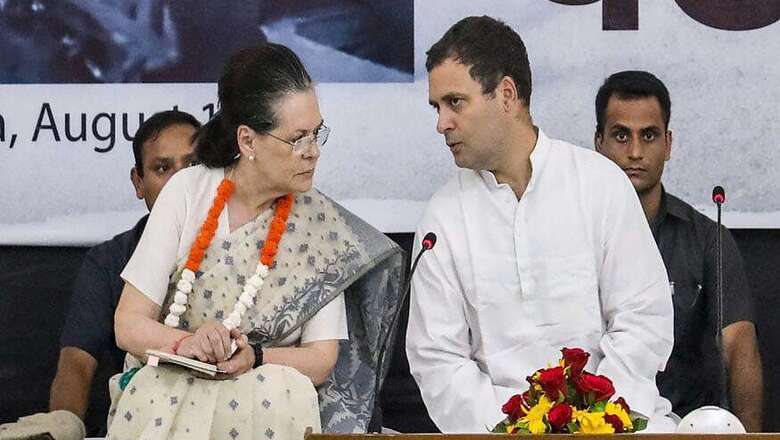
views
New Delhi: The defeat of Congress president Rahul Gandhi from the party’s bastion, Amethi, is just the tip of the iceberg. The juggernaut of Bhartiya Janata Party (BJP) not only relegated the grand old party to yet another paltry sum of seats, it also decimated its arch rival in almost 90 per cent direct contests.
Of the 186 direct face-offs between the BJP and Congress, the former won 170 seats, which amounts to 91.4 per cent strike rate. The saffron party had bagged 162 of these seats in the 2014 elections when its strike rate against the Congress in direct fights was almost 84 per cent. The Congress, which had won 24 of these seats in last elections, has this time come down to 15, with a loss of nine seats in a bipolar contest with the BJP, its arch rival.
Results suggest that the Congress could not survive the saffron storm in places where the two national parties witnessed a bipolar contest. As a result of this defeat, the grand old party has no representation from 20 states. Even from bigger states like Maharashtra and Madhya Pradesh, the Congress would be sending just one MP each.
Only a few months ago, the Congress had performed well in state elections in Rajasthan, Madhya Pradesh and Chhattisgarh, but those victories have also not translated into any gains in 2019. The three states send a total of 65 MPs to the parliament and irrespective of winning Assembly polls in these state just six months ago, the Congress managed to win only two seats. The party was again in a direct fight with the BJP in all these seats.
In Rajasthan, the BJP swept by winning all the 25 seats where its main competitor was the Congress. In 2014 too, the saffron party had swept the state, winning all seats.
The other important state where the saffron party was in a direct contest with the Congress was Gujarat. There too, the BJP won all 26 Lok Sabha seats for the second consecutive time.
The BJP repeated the same feat in the hill states of Himachal Pradesh and Uttarakhand. Both the states send nine MPs to the parliament.
In Maharashtra, a key state wherein the Congress hoped to perform relatively better, saw a similar trend. Of the total 16 direct contests with the BJP, the Congress could only manage one seat. Here, its candidate Balubhau alias Suresh Narayan Dhanorkar, won against the BJP’s Shri Hansraj Gangaram Ahir, an incumbent MP.
Some key Congress leaders who lost to the BJP candidates include Priya Dutt, Nana Patole and former chief minister of the state, Ashok Chavan.
Another important state where the Congress was in a neck-and-neck fight with the saffron party was Madhya Pradesh. Here too, the BJP routed Congress in all but one seat. The saffron party won 28 of these contests, even performing better than what the exit polls had predicted.
After emerging as the single largest party in Madhya Pradesh with 114 seats in the assembly polls last December, only a few could imagine the magnitude of the blow the Congress would be dealt at the hands of BJP. The grand old party performance has been even more dismal than 2014 when it managed to win only two seats, Chhindwara and Guna.
This time its tally stands at a dismal one, a figure no one could imagine was possible after the party’s resurgence in 2018, which had seemingly halted BJP’s 15 years of rule in the state. The only seat the grand old party could win was Chhindwara. The party couldn’t even save Guna, a traditional seat of the Scindias, from the ‘Modi wave’.
In Uttar Pradesh, where the Congress was in a direct fight with the BJP in two seats of Amethi and Raebareli, it only managed a single win. Congress leader Sonia Gandhi won from Raebareli Lok Sabha seat, defeating her rival, BJP candidate Dinesh Pratap Singh. Gandhi won by a margin of 1,67,178 votes. In Amethi, Rahul Gandhi lost to BJP’s Smriti Irani by margin of 55,120 votes.
Similar trends were recorded in Jharkhand, Assam, Punjab, Karnataka, Kerala, Tamila Nadu, and Jammu and Kashmir.
In Jharkhand, the Congress was in a direct fight with the BJP on 7 seats — Chhatra, Lohardaga, Ranchi, Khunti, Hazaribagh, Dhanbad and Singhbhum. It only won the Singhbhum Lok Sabha seat.
Similarly, in Assam the Congress was locked in a bipolar contest with the BJP and emerged victorious on one seat, while the BJP won 8.
Down south, Karnataka too witnessed a similar trend. The state has 28 Lok Sabha seats. Out of these, BJP and Congress were locked in a head to head fight on 21 seats. The saffron party managed to win 20. The only seat the Congress won from these 21 Lok Sabha seats was of Bangalore Rural, where D.K Suresh won against BJP’s Ashwat Narain.
The national capital also saw BJP keeping the Congress at bay in direct contests. The two parties went head to head in 5 out of 7 seats in Delhi. The saffron party won all of them. Punjab witnessed three such fights, in which the BJP won two and the Congress won one.
The only two states where the Congress could fare relatively better against the BJP, winning two seats in direct contests, were Baharampur and Maldaha Dakshin in West Bengal, and Korba and Baster (ST) in Chhattisgarh.
Kerela and Tamil Nadu were the only two states where the saffron party couldn’t win any seat against the Congress in a direct fight. In these states, the two parties were locked in a bipolar contest on one Lok Sabha seat each.




















Comments
0 comment